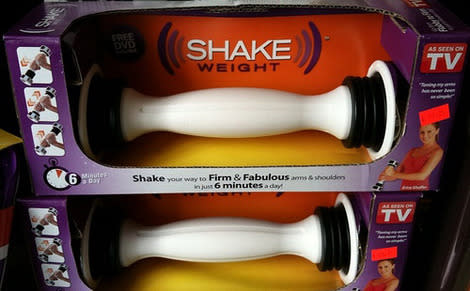STUDY: Do Shake Weights Really Work?

By Scott Douglas, Runner's World Newswire
Shake Weights, heavily advertised on TV, have entered the public consciousness enough to have been parodied on "South Park" and "Saturday Night Live," among other venues. While the jokesters mock the (admittedly easy-to-mock) ads, science marches on, asking the fundamental question: Do they work as advertised?
Not really, according to research published in the Journal of Sports Science & Medicine.
Shake Weights contain weights at the ends attached to the handle by a spring. According to the manufacturer, shaking the weights stimulates sufficient muscular activity to reduce fat and increase muscle mass in the upper-body areas targeted. For this study, 25 young adults did three exercises that are part of the prescribed Shake Weights routine--chest shake, biceps shake and triceps shake--using Shake Weights and conventional dumbbells.
RELATED: Innovative Gym Equipment That Actually Works
While the participants did the shaking exercises, the researchers measured muscle activity in the major muscles the exercises were supposed to target. The researchers found no difference in amount of muscle activity between using Shake Weights and conventional dumbbells, suggesting that, when used as recommended by the manufacturer, Shake Weights were no more effective than standard hand weights.
Moreover, the researchers wrote, "no muscle group during any of the [Shake Weight] trials exhibited [a maximal voluntary isometric contraction] over 60%, the level necessary to increase muscular strength."
MORE: When You Should Stop Strength Training
In other words, not only were Shake Weights no more effective than regular weights when used in the manufacturer-recommended exercises, but those exercises were insufficient to produce the desired muscular gains.
As many fitness experts have pointed out, when used as prescribed, Shake Weights lack two key elements of strength training: They don't work the muscles through a nearly full range of motion, and they don't have a means of progression (i.e., adding more weight) once the initial workout is no longer challenging.
TRY INSTEAD: The Only 10 Strength Exercises You'll Ever Need
More from Runner's World:
6 Reasons Your Weight Loss Plan Isn't Working
